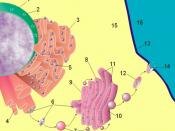ÃÂæAn optical microscope enlarges the image of cells. This is called magnification. To show us small structures within cells, a microscope must be able to distinguish between objects that are close together. This is called resolution
.
ÃÂæOptical microscope passes light through a specimen to be viewed. Maximum magnification is about 1500 times and its limit of resolution is about 2um
ÃÂæElectron microscope uses beams of electrons. Its maximum magnification is about 500,000 times and its limit of resolution is about 1nm. A transmission electron microscope passes beams of electrons through a specimen to be viewed. A scanning electron microscope bounces beams of electrons off the surface of the specimen to be viewed.
ÃÂæProkaryotic cells do not have nucleus. Only bacteria have prokaryotic cells. They are surrounded by a cell wall and a plasma membrane. Some are surrounded by a capsule. Ribosomes are the only organelles found in their cytoplasm.
ÃÂæEukaryotic cells have a nucleus that is separated from the cytoplasm by a nuclear envelope. Organisms other then bacteria have eukaryotic cells. They are surrounded by a plasma membrane. Some are surrounded by a cell wall. Their cytoplasm contains a variety of organelles.
ÃÂæEach organelle has a particular function.
MITOCHONDRIA make ATP
CHLOROPLASTS make CARBOHYDRATES in photosynthesising cells
RIBOSOMES make PROTEINS
ENDOPLASMIC RETICULUM forms CHANNELS through cytoplasm that helps to distribute substances quickly around cells.
GOLGI APPARATUS found in some cells, STORES SUBSTANCES that cells have made before they are carried to the surface of the cell by small VESICLES.
LYSOSOMES are vesicles that contain protein digesting enzymes.
ÃÂæCells have at least one chromosome that controls its activities. Prokaryotic cells have a single, circular chromosome that is in their cytoplasm. Eukaryotic cells have several linear chromosomes that are found in the nucleus.
ÃÂæCell organelles must be collected from cells...


